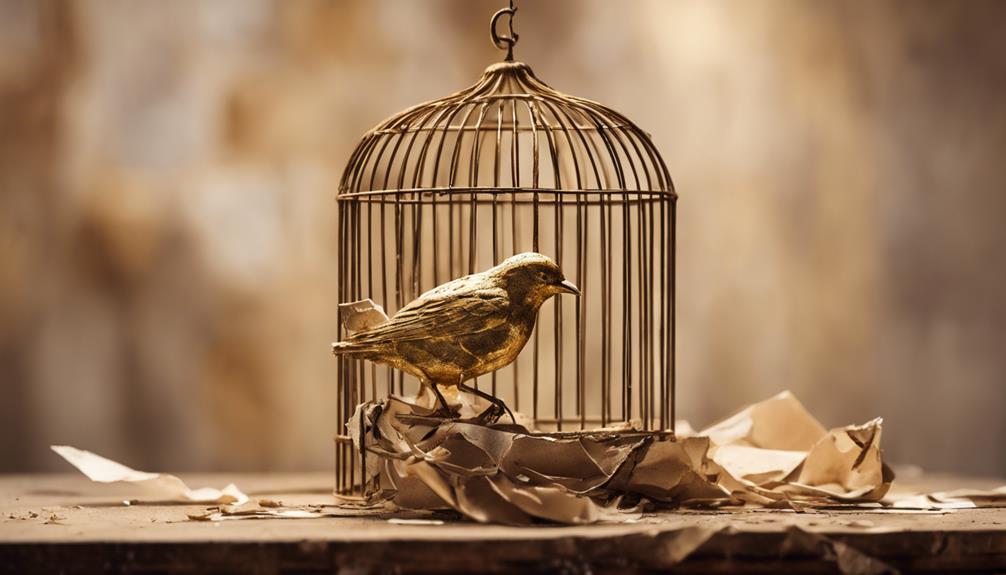As you explore the complexities of Maya Angelou's "Caged Bird," you'll uncover a rich tapestry of themes and symbolism. The caged bird, a powerful metaphor, represents the suffocating grip of oppression, stifling personal growth and creativity. In contrast, the free bird embodies unbridled freedom and empowerment, inspiring autonomy and creative expression. Through a nuanced exploration of freedom, oppression, and the human condition, the poem's structure and themes emerge, revealing a profound critique of societal constraints. As you continue, the intricacies of the poem's language, imagery, and symbolism will unfold, illuminating the human experience and the universal longing for freedom.
Unpacking the Caged Bird Metaphor
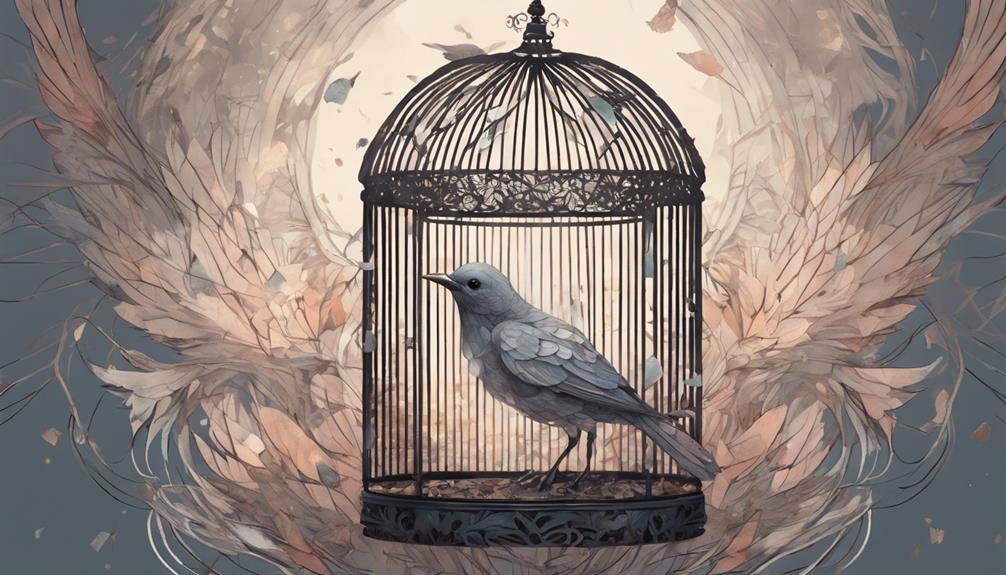
As you explore the rich tapestry of Maya Angelou's poetry, the caged bird metaphor, a potent symbol of oppression and liberation, emerges as a recurring motif, begging the question: what lies at the heart of this powerful allegory? This metaphor serves as a powerful tool for exploring the complexities of the human experience, particularly when it comes to the theme of caged identity. The bird, confined to its cage, represents the ways in which societal expectations and norms can restrict individual freedom and creativity. This social confinement can stifle personal growth, creativity, and self-expression, leading to feelings of frustration and disillusionment. In Angelou's work, the caged bird becomes a powerful symbol of the struggles faced by marginalized communities, who have historically been subjected to systemic oppression and social confinement. By examining the caged bird metaphor, you can gain a deeper understanding of the ways in which societal structures can shape and constrain individual identity.
Free Bird Symbolism Explained

In Maya Angelou's poetry, the free bird, liberated from its cage, embodies the ultimate triumph of the human spirit, representing the unbridled freedom to soar, unfettered by societal constraints, and serving as a potent symbol of empowerment, self-actualization, and unencumbered expression. As you explore further into the symbolism, you'll discover that the free bird's unbridled flight represents the pinnacle of human aspiration – to transcend the shackles of oppression and soar into the domain of limitless possibilities.
In stark contrast, the caged bird, trapped in its prison of societal expectations, embodies the antithesis of freedom, representing the suffocating grip of conformity. The free bird's liberation, thus, serves as a powerful antidote to the wingless dreams and flightless souls that succumb to the crushing weight of oppression. Through the free bird's symbolism, Angelou poetically articulates the human yearning for autonomy, creative expression, and the unbridled pursuit of one's passions. As you reflect on the free bird's symbolism, you'll come to realize that it is an emblem of hope, inspiring you to shatter the constraints that bind you, and spread your wings, unencumbered, into the vast expanse of human potential.
Poem Structure and Themes
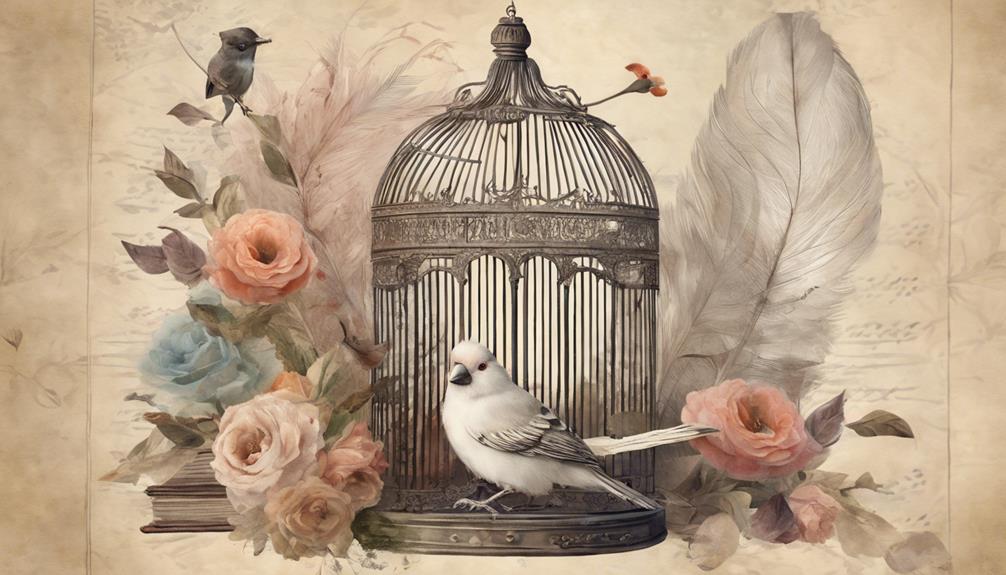
Through its intentional stanzaic arrangement and nuanced linguistic choices, Maya Angelou's 'Caged Bird' poem masterfully weaves together a rich tapestry of themes that explore the complexities of freedom, oppression, and the human condition. As you explore the poem's structure, you'll notice that each stanza serves as a distinct unit, examining a specific aspect of the caged bird's experience. The use of poetic devices such as metaphor, simile, and personification adds depth and complexity to the poem, enabling you to unravel the intricate web of emotions and ideas.
In conducting a stanza analysis, you'll observe that the poem's six stanzas are carefully crafted to build upon one another, creating a sense of tension and release. The first stanza introduces the central theme of freedom, while subsequent stanzas develop this idea through the contrast between the free bird's exuberance and the caged bird's despair. As you examine the poem's structure, you'll uncover a nuanced exploration of the human condition, one that addresses the universal longing for freedom and autonomy.
Speaker's Voice and Tone Analysis
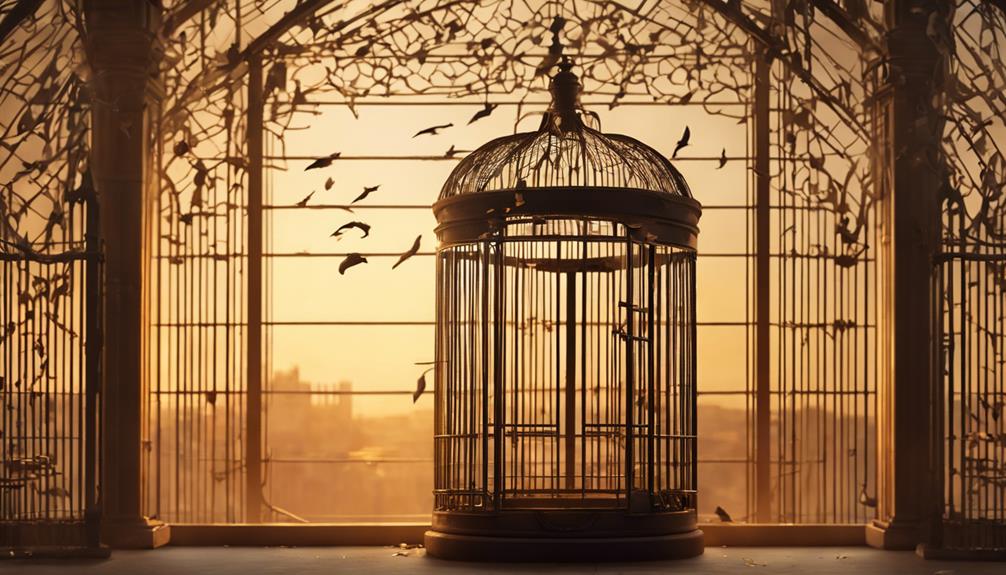
Upon closer examination of Maya Angelou's 'Caged Bird,' you'll discover that the speaker's voice assumes a distinct tone, oscillating between despair and defiance, which serves to underscore the poet's scathing critique of oppression. This tonal duality is vital in conveying the emotional resonance of the poem, as it allows the reader to viscerally experience the anguish and resistance that define the human experience under oppressive conditions. The speaker's voice, in this sense, becomes a powerful instrument of protest, imbuing the poem with an air of urgency and moral indignation. Moreover, the tone's oscillation between despair and defiance can be seen as a deliberate authorial choice, underscoring the poet's intent to expose the brutal realities of oppression while also affirming the human spirit's capacity for resistance and resilience. Through this masterful manipulation of tone, Angelou crafts a poem that not only critiques oppression but also inspires collective action and solidarity.
Imagery and Symbolism Breakdown

As you explore the rich tapestry of Maya Angelou's 'Caged Bird,' you'll find that the poet's strategic deployment of imagery and symbolism serves to amplify the poem's emotional resonance, underscoring the dehumanizing effects of oppression while also illuminating the human spirit's capacity for resilience.
Through sensory exploration, Angelou masterfully conjures vivid images that evoke a visceral response from the reader. The "caged bird" itself becomes a potent symbol of confinement, while the "free bird" embodies the longing for liberation. The poet's use of figurative language, such as metaphor (e.g., "his wings are clipped and his feet are tied") and personification (e.g., "the free bird leaps on the back of the wind"), creates a rich tapestry of meanings that invite close reading and interpretation.
Themes of Freedom and Oppression
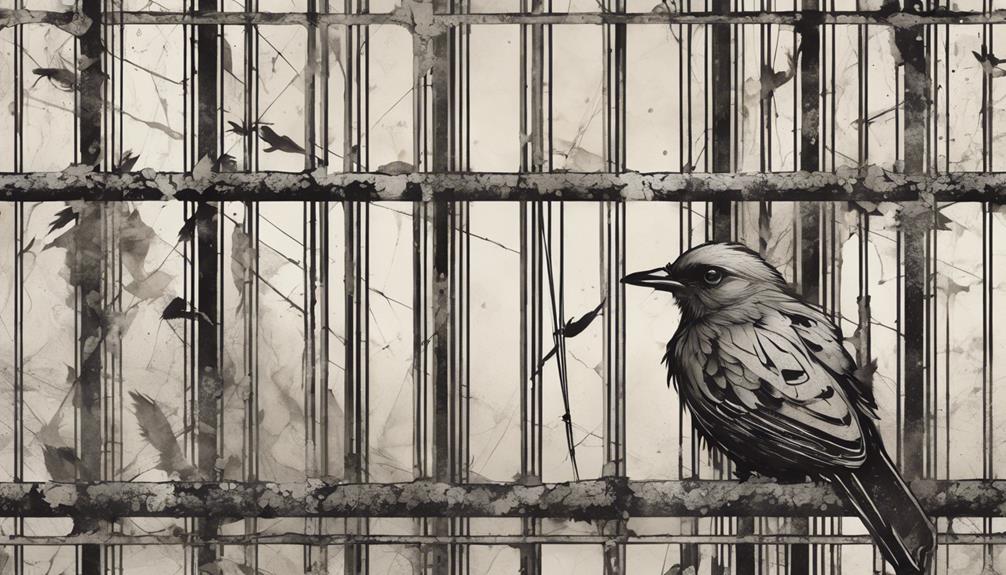
You'll discover that the dichotomy between freedom and oppression serves as the poem's emotional axis, with the caged bird's struggles and the free bird's exuberance together illuminating the universal human quest for autonomy and self-expression. This dichotomy highlights the social hierarchy that perpetuates oppression, where certain groups are marginalized and denied their basic human rights. The caged bird, a powerful symbol of oppression, represents the struggles of those who are trapped in a system that denies them freedom and autonomy. In contrast, the free bird embodies the human desire for liberty and self-expression, emphasizing the importance of human rights and dignity. As you explore further into the poem, you'll realize that the themes of freedom and oppression are intertwined, with the former serving as the antidote to the latter. The poem thus becomes a powerful commentary on the human experience, emphasizing the need to dismantle oppressive systems and promote equality and justice for all.
Frequently Asked Questions
What Inspired Maya Angelou to Write "Caged Bird"?
As you explore Maya Angelou's inspiration behind 'Caged Bird,' you'll uncover a personal reflection of her own experiences with racism and oppression. The poem serves as a powerful literary device, allowing Angelou to express the suffocating feelings of being trapped, much like the caged bird. By investigating her own life, Angelou crafted a poignant metaphor that resonates with readers, making 'Caged Bird' a timeless masterpiece that continues to echo with emotional depth.
Is the Poem Based on a True Story or Experience?
As you explore the poem, you'll notice it's rooted in Maya Angelou's personal experiences, particularly her struggles with racial identity. The caged bird serves as a powerful metaphor for the stifling of personal freedom, echoing the oppressive realities of racial segregation. While not a direct recounting of events, the poem draws from Angelou's own life, weaving together the threads of her experiences to create a poignant exploration of the human quest for liberation.
How Does the Poem Relate to the Civil Rights Movement?
As you explore the poem, you're struck by the haunting echoes of racial oppression, where the caged bird's cries resonate with the struggles of a marginalized people. The poem is a scathing indictment of social inequality, mirroring the Civil Rights Movement's fight against systemic injustice. Maya Angelou's masterful strokes paint a vivid picture of a society where freedom is a distant dream, and the bird's longing for liberty becomes a powerful allegory for the struggle for racial equality.
What Is the Significance of the Bird's Singing in the Poem?
As you explore the poem, you'll notice the bird's singing serves as a potent symbol of resistance. The bird's melodic rebellion against its confinement embodies the yearning for freedom, a fundamental human right. The singing becomes a freedom symbol, defying the oppressive forces that seek to silence it. Through its song, the bird asserts its autonomy, refusing to be silenced or defeated, mirroring the struggles of marginalized communities fighting for liberation.
Can the Poem Be Interpreted as a Feminist Statement?
As you explore the poem, you'll find that the caged bird's plight can be seen as a powerful feminist statement. The bird's confinement symbolizes the societal constraints placed on women, limiting their freedom and autonomy. In a patriarchal society, gender roles are rigidly defined, and women are often relegated to secondary status. The poem's themes of oppression, silence, and longing for freedom can be seen as a scathing critique of these societal norms, highlighting the need for women's empowerment and liberation.
